
NPS photo
Lizards make their way through their environments in many ways. Some are sluggish like the Gila monster, while others you may only see in a flash, like the zebra-tailed lizard. Some lizards will climb walls, while others are ground-bound. Some are distinguished by their color, while others are nearly invisible on the desert backdrop. Evenings and mornings in the summer, and days in the winter are good times to look for lizards in the Monument, when they may be sunning themselves on rocks, or prowling for food. Look out for males making territorial displays of prowess through "push-up" like motions from on top of rocks.
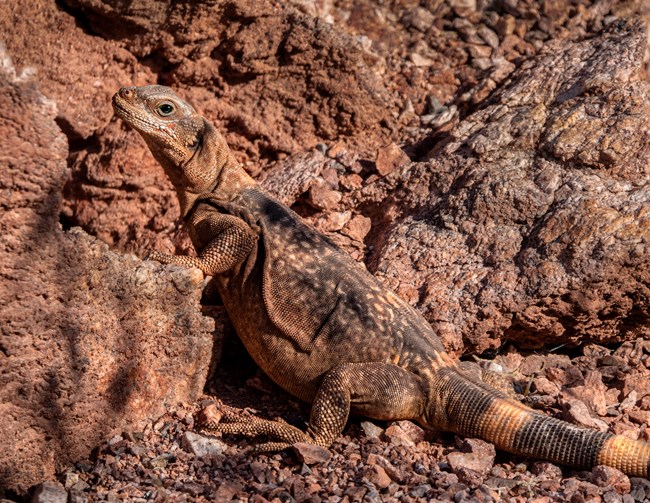
NPS photo/Andrew Cattoir Chuckwalla (Sauromalus ater)Common chuckwallas are in the iguana family and are herbivores. Most of their diet comes from leafy desert vegetation, though they particularly enjoy cactus fruits such as that of the fishhook barrel cactus and various types of cholla. Many common desert plants like the ocotillo and agave do not have enough leafy vegetation to be a food source for the common chuckwalla, but they are handy places to get out of the heat of the sun around midday. Identify this LizardChuckwallas are generally large lizards, growing to be about the size of a small baguette (20 inches or 50 cm long), with a thick, blunt tail. Adult males have dark gray legs and head, an orangish midsection, and a yellow tail. Females are dusty brown or gray with orange flecks. Along roadways in the Monument, you may notice male chuckwallas standing atop rockpiles, performing “pushups” to mark their territories. 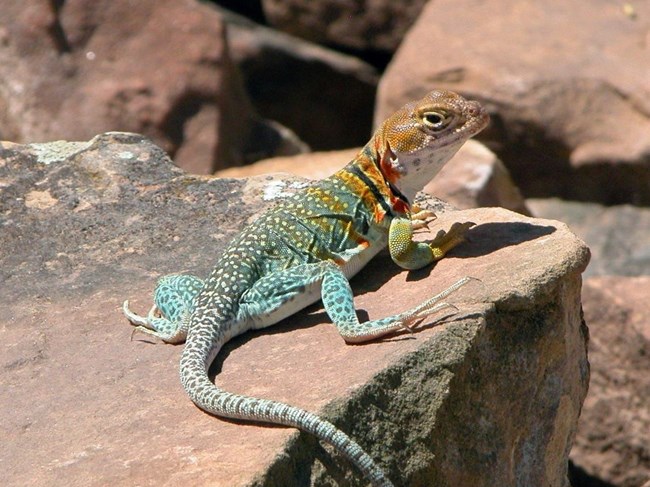
NPS Photo Collared Lizard (Crotaphytus collaris)This lizard is known by many names, including the eastern collared lizard, yellow-headed collared lizard, and common collared lizard among others. There are 5 known subspecies of this lizard, which are named for the black band of stripes around their neck. Their diet consists mainly of insects and sometimes other lizards! Identify this LizardThese vibrant lizards grow from 3-4.5 inches (7.5-11.5 cm) from head to vent, and up to 15 inches to the end of its tail. Males have beautiful teal bodies, a yellow-brown head with yellow stripes on the tail and back, yellow-orange throats with two black "collar" stripes, and a white belly. Females have more subdued coloring of greys and browns with a white bellow, but have the distinctive "collar" stripes, as seen at the top of this page. 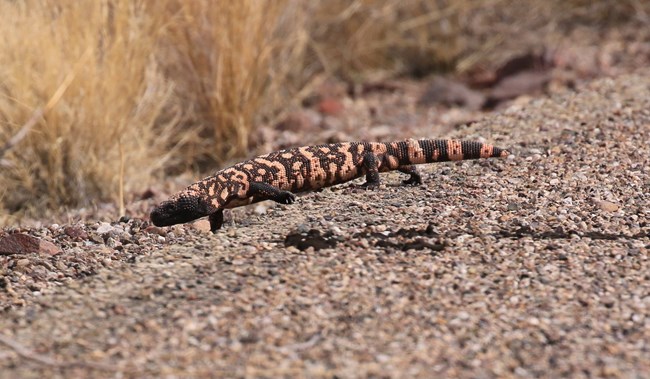
NPS photo Gila monster (Heloderma suspectum)Revered in several Native cultures as a killer or a medicinal animal, the Gila monster is perhaps the only venomous lizard in the United States. This creature has a nasty bite if cornered, and combined with folk lore, the Gila monster developed a bad reputation with early miners who would kill the lizard out of irrational fear. Despite its fearsome name and toxic nature, Gila monsters are not considered particularly dangerous. They will not perceive you as prey and will prefer to avoid you rather than engage in a confrontation. However, they will bite when threatened and can move surprisingly fast. Identify this LizardThe Gila Monster is the largest living lizard native to the United States, adults growing to 20 inches long (50 cm) and weighing as much as a brick. Their stout body, powerful head, and swollen tail are distinguishing features. Bright orange to salmon-pink bands over black skin lets predators know that the Gila monster packs a punch. Gila monsters do not possess fangs like snakes, but instead have serrated teeth like steak knives. The venomous saliva wicks into the wound from the edges of the teeth. 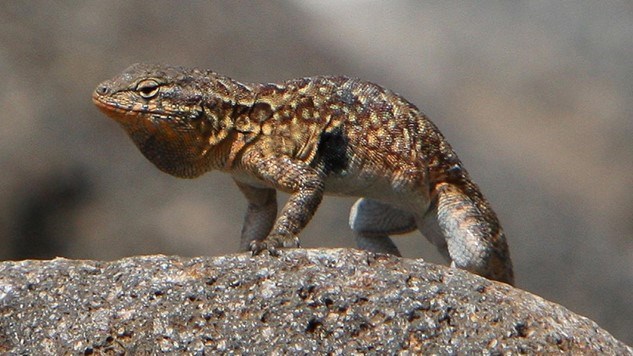
NPS Photo Side-Blotched Lizard (Uta stansburiana)The side-blotched lizard can be found on rocks, around structures, and near bushes throughout Organ Pipe Cactus National Monument. They are very common and are most active during the day, making them one of the most often spotted reptiles in the monument. Researchers in the early 2000s revealed this lizard has some of the most complex mating behaviors in the Sonoran Desert. Males fall into three categories defined by the breeding colors they develop on their throats and engage in a mating version of “Paper-Rock-Scissors.” Identify this LizardThese small lizards grow to 1.5-2.5 inches ( 3.5-6.5 cm) long from head to vent (where the tail meets it's backside). Look for a beautiful brown and pale yellow "spotted" pattern along these lizards' backs and for vibrant orange, blue, or yellow patches under its chin, along its belly, and its tail. 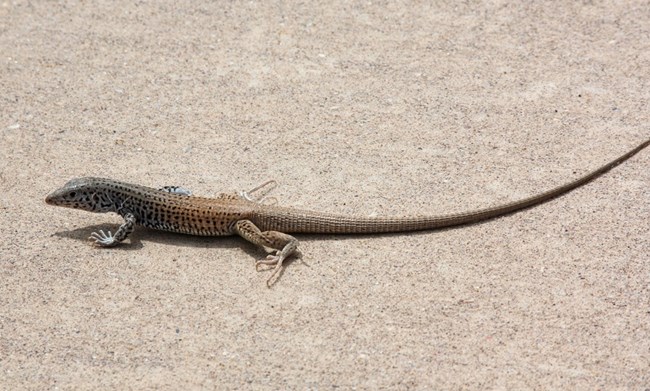
NPS Photo Whiptails (Cnemidophorus burti and tigris)You may see midsize lizards scurry across the road or trail with tails as long as their bodies. These are the two species of aptly named whiptail found in Organ Pipe Cactus National Monument: the canyon whiptail (Cnemidophorus burti) and the western whiptail (Cnemidophorus tigris).Whiptails are insectivores, meaning they eat insects and other small invertebrates. They help control insect populations and provide food for larger reptiles and birds. Identify this LizardCanyon whiptails are 3.5 - 5.5 inches (9 - 14 cm) and western whiptails are about 4 inches (10 cm) in length from head to vent, and both may measure more than 12 inches (30.5 cm) if measuring from head to the end of its tail. Both species are brownish with beautiful spots. Western whiptails have brown/black spots while canyon whiptails have yellow/orange spots. 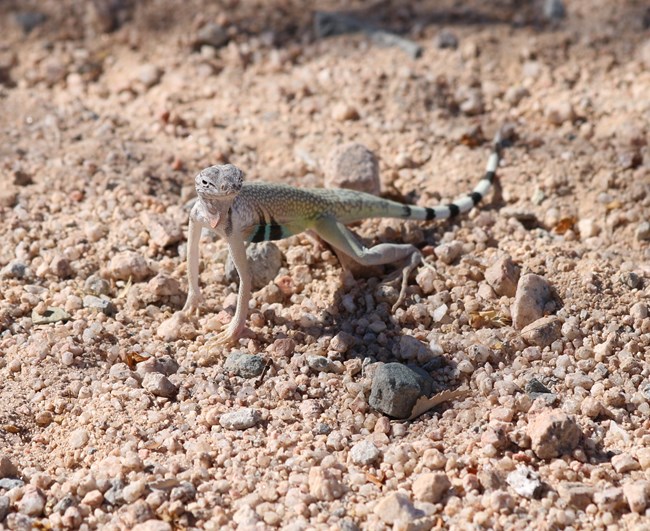
NPS photo Zebra-tailed lizard (Callisaurus draconoides)Zebra-tailed Lizards are named after the bold black and white stripes on the underside of their tails. When resting, the Zebra-tailed Lizard will curl its tail up, exposing the stipes, and will wag its tail side to side. This may be to distract predators or draw attention away from their face and body and towards their tail, which can break off and regenerate later, in case it is grabbed by a hungry predator. Identify this LizardZebra-tailed lizards are small, slender ground dwelling reptiles. They grow to a length of about 4-7 inches long (10-18 cm). These lizards have sandy-beige backs with dark brown bars and splotches, and bright white bellies. Males may have blue patches on their sides. Females lack any blue patches, and the name-sake bands on the tail are usually light or absent. If you see one dart past you, try to keep an eye on it until it stops and make note of any dark stripes on the lizard. More About Sonoran Desert Reptiles |
Last updated: September 2, 2023
